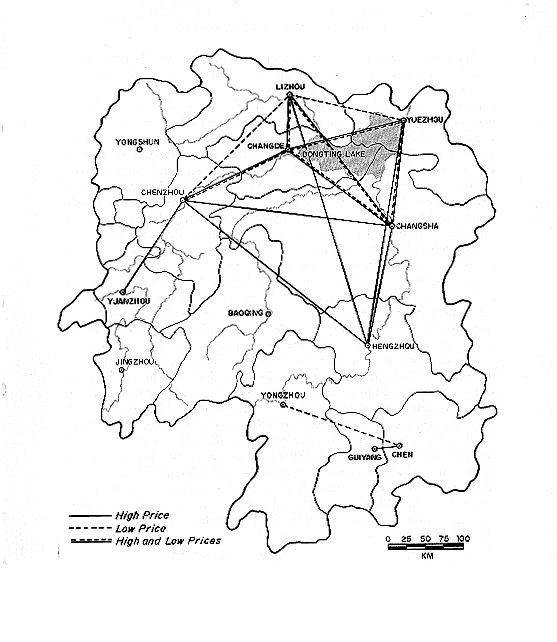Spatial Structures of the Rice Trade: Qualitative Evidence
Hunan's eighteenth-century commerce largely followed the province's river systems. Each of the four major rivers—Xiang, Zi, Yuan, and Li—flowed into Dongting Lake, located in the northeastern part of the province. The Xiang River was by far the most important river, draining nearly half the province's land area. Not surprisingly, merchants along this river collected and shipped considerable amounts of rice destined for export out of the province. A 1753 investigation of specialized rice markets, covering 49 of Hunan's 56 counties, found 16 counties in which major rice markets existed and three additional counties where minor rice markets also served the export trade.[5] These 19 counties—Anxiang, Baling, Chaling, Changsha, Hengshan, Hengyang, Huarong, Linxiang, Liuyang, Longyang, Shanhua, Taoyuan, Wuling, Xiangtan, Xiangxiang, Xiangyin, Yiyang, Youxian, and Yuanjiang—were all located in five of Hunan's 13 prefectures; three of the prefectures (Changde, Lizhou, and Yuezhou) bordered Dongting Lake, while the remaining two (Changsha and Hengzhou) were south of Dongting Lake on the Xiang River. Major markets contained the facilities to accommodate boats, store grain, and arrange transactions; minor markets sent rice to these major markets for export. Map 4.1 displays the 16 counties with specialized rice markets and the three additional counties with export surpluses.
By adding information from other sources, we can piece together commercial rice flows in other parts of the province. Small quantities sometimes moved along Hunan's other three major rivers and their tributaries. Along the Zi River, rice moved from Wugang to Shaoyang and from this point to Xinhua; other shipments of rice reached the tea-producing county of Anhua further downstream. These shipments along the Zi River probably did not reach Dongting Lake. Protests against the trade in the early nineteenth century make clear, however, that even these small, short-distance, nonexport shipments were significant sources of food to the people who depended on them.[6] In contrast, gazetteers provide no evidence of trade crossing county borders anywhere along the Li River.[7]
[5] Hunan shengli cheng'an hulü (1820), 23.2a–23b. For a discussion of the report, see Shigeta, "Shinsho ni okeru Konan komeshijo," 17–21. Rawski, Agricultural Change , p. 105, puts in tabular form information presented by Shigeta from the original.
[6] Deng Xianhe, "Lun huangzheng," Hunan wenzheng: guochao wen , 29.23a–24b, Xinning xianzhi (1893) 20.19a–21a. Repeated struggles over this flow of grain demonstrate the social and political importance of what in economic terms may be quite minor. See Kojima Shinji, Taihei tenkoku kakumei no rekishi to shiso (Tokyo, 1978), pp. 117–26, and R. Bin Wong, "Food Riots in the Qing Dynasty," Journal of Asian Studies 41, no. 4:774–79.
[7] Rice was grown in each of three counties along the Li River but was not a major food crop in any of them; more important was the combination of winter wheat, corn, and millet. Cotton and hemp cloth, like grain, circulated within county borders, while seed oils and mining products made their way downstream to the lake region. Sangzhi xianzhi (1873), 2.25–37; Yongshun fuzhi (1763), 10.5a; Shimen xianzhi (1818), 18.72a–73a, 52.49a–53a; Shimen xianzhi (1873), 3.48–49.

Map 4.2.
Correlations of Annual Price Differences for High-Grade Rice in Qing Dynasty Hunan.
(See p. 138 for Map 4.1.)
Along the Yuan River available sources allow us to reconstruct a more complex situation. Although they inform us that people in Chenzhou depended on imports from other counties, they do not tell us where the boats came from. The neighboring upstream counties of Luxi, Chenxi, and Xupu were unlikely suppliers of rice because of their own food supply limitations.[8] It appears, therefore, that the boats came upstream from the fertile paddy areas near the lake, apparently carrying rice that would otherwise flow out of the province with the export trade. Additional trade, including sales to Huitong, flourished along the upper reaches of the Yuan and its tributaries in Yuanzhou and Jianyang. These movements in southwestern Hunan, which also carried grain across the Guizhou border, were physically separate from the movements in downstream areas between the lake and Chenzhou.[9]
In southern Hunan small amounts of rice appear to have moved across prefectural boundaries. For instance, rice grown in Lanshan and Xintian fed miners in Guiyang. Sources also provide early eighteenth-century evidence of shipments of rice from Yongzhou to Hengzhou.[10] The southern mountain region within which rice was sold to feed miners also, at least for a while, sent rice into the Xiang River export trade. Map 4.1 also shows those counties outside the export zone in which rice trade is noted in gazetteer sources.
In summary, the export trade dominated rice movements in Hunan above the local level but coexisted with spatially separate movements along the Zi and Yuan rivers and in the southern mountains. Qualitative data indicate some rice trade crossing county borders in ten of Hunan's 13 prefectures, but only half of those ten participated directly in the province's Yangzi River export trade. The evidence we have just reviewed establishes the outlines of separate patterns of grain trade within the province. But this information cannot answer two important questions. Were the physically distinct movements of rice outside the export zone economically independent of the interprovincial trade? What degrees of market integration were achieved within the export zone and in areas beyond it? Our analysis of grain prices provides some answers.
[8] On Chenzhou, see Yuanling xianzhi (1873), 8.1a; on the counties upstream, see Fukuda Setsuo, "Shinmatsu Konan no noson shakai," Fukuoka joshi tandai kiyo 8:33, 34, 51.
[9] Shigeta, "Shinsho ni okeru Konan komeshijo," pp. 24–25; Hunan shengli cheng'an hulü , 23.2a–23b. On the route out of Hunan into the Southwest, see James Lee, State and Economy in Southwest China, 1250 to 1850 (Cambridge, forthcoming), chap. 3.
[10] Guiyang zhouzhi (1868), 6.18–19; Lanshan xianzhi (1933), 11.53. For occasional entry of Yongzhou rice into the Xiang River export trade, see Qiyang xianzhi (1765), 4.7a.